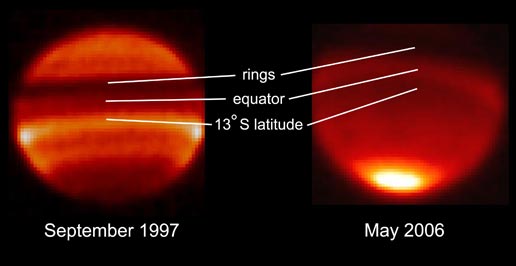Reading something like this makes me hopeful that we’re no longer in the infant stage of our understanding of our solar system: we’ve been patient and observant while growing in our knowledge. Scientists have discovered a wave pattern, or oscillation, in Saturn’s atmosphere only visible from Earth every 15 years. This discovery was made only because we’ve been studying Saturn from ground based telescopes for about 22 years. Combined with the Cassini spacecraft’s observations of temperature changes in the giant planet’s atmosphere over time, we’re gaining a better understanding of Saturn and discovering not only how unique it is, but also that Saturn has something in common with Earth. Our own planet has these oscillations too, and so does Jupiter. “You could only make this discovery by observing Saturn over a long period of time,” said Glenn Orton, of JPL, lead author of the ground-based study. “It’s like putting together 22 years worth of puzzle pieces, collected by a hugely rewarding collaboration of students and scientists from around the world on various telescopes.”
The image above shows a pattern ripples back and forth like a wave within Saturn’s upper atmosphere. In this region, temperatures switch from one altitude to the next in a candy cane-like, striped, hot-cold pattern. The temperature “snapshot” shown in these two images captures two different phases of this wave oscillation: the temperature at Saturn’s equator switches from hot to cold, and temperatures on either side of the equator switch from cold to hot every Saturn half-year.
The image on the left was taken in 1997 and shows the temperature at the equator is colder than the temperature at 13 degrees south latitude. Conversely, the image on the right taken in 2006 shows the temperature at the equator is warmer.
Results from Cassini’s infrared camera indicate that Saturn’s wave pattern is similar to a pattern found in Earth’s upper atmosphere, which takes about two years. A similar pattern on Jupiter takes more than four Earth years. The new Saturn findings add a common link to the three planets.
Cassini scientists hope to find out why this phenomenon on Saturn changes with the seasons, and why the temperature switchover happens when the sun is directly over Saturn’s equator.
Original News Source: JPL Press Release


Great to see work arising from the scientists & enthusiasts, contributing to our knowledge. Let’s hear more about these kinds of projects